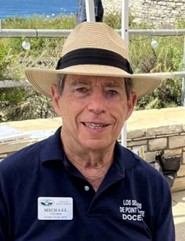
(Feb 27, 2024)
Michael Friedman is Chair of the Speakers Bureau of Los Serenos de Point Vicente (https://losserenosrpv.org/), a volunteer organization founded in 1984 by the city of Rancho Palos Verdes. It provides community interpretive and educational services about the natural and cultural history of the PV Peninsula and coastal waters.
Kelp is not a plant, because it has no roots. It is a multicellular form of algae that needs a rock surface to attach to, so that it can get nutrition from ocean currents. The Giant Kelp in our coastal waters can grow 2 feet per day, up to 200 feet, with the top floating on the ocean surface as a canopy. A multibillion-dollar industry uses it in food, cosmetics, industrial and medical products, foam on beer, toothpaste, humidifiers and lubricants. Only the top is harvested. Abalone mollusks eat it, and many fish shelter and breed there. The fishing industry complained about sea otters catching fish there, so the otters were removed in many areas, resulting in sea urchins multiplying and destroying the kelp beds by chewing through the kelp holdfasts. 75% of kelp beds have been lost.
DDT dumping offshore is a huge problem here. The Montrose company in the LA Harbor area produced half of the world supply of DDT from 1947-1982. Then the plant was closed, the area was designated as a US Superfund hazardous waste site, and the company was sold in 1987 to a foreign company (which has escaped liability). At least 27,000 barrels (thousands of tons) have been dumped off the coast. The DDT is leaking and poisoning ocean plant and animal life here. (Sea lions are now developing cancer, and brown pelicans’ eggs for years became too fragile for survival because of DDT contamination of their food.)
DDT is a known carcinogen that was banned in the US in 1972. DDT also disrupts the hormone system and promotes diabetes, obesity and nervous system hypersensitivity. In the body, DDT binds to fat and bio-accumulates because it cannot be metabolized. It is transmitted in the placenta and breast milk. There is no available method to detoxify vast areas of ocean water.